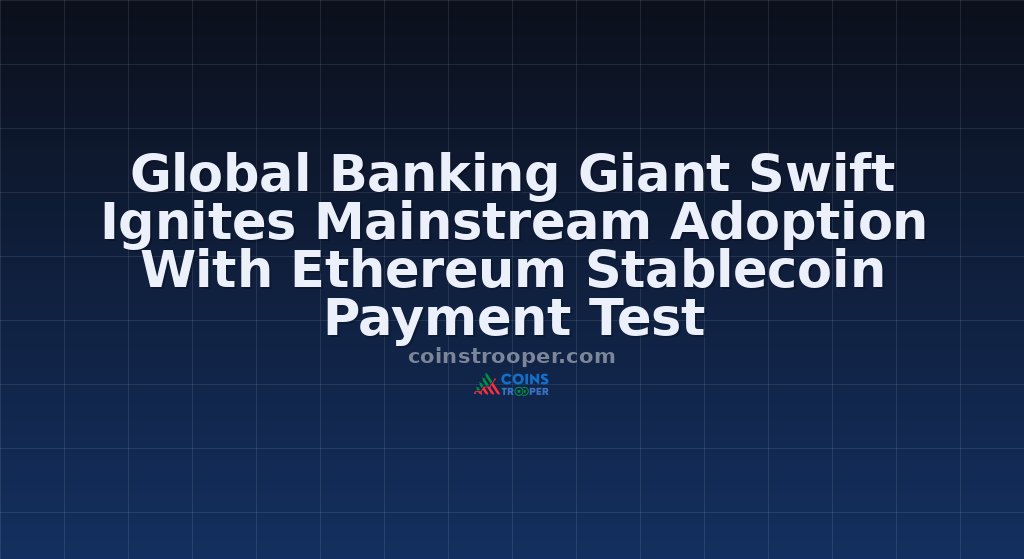Global Banking Giant Swift Ignites Mainstream Adoption With Ethereum Stablecoin Payment Test

- The trial marks a significant step for SWIFT, which connects over 11,000 financial institutions and processes billions of messages annually.
- Traditionally, SWIFT has functioned as a secure messaging service that transmits payment instructions between banks.
- SWIFT has emphasized that this effort goes beyond transmitting digital cash transfers, expanding its role into comprehensive on-chain activities.
- Notably, Linea was selected for its zk-rollup technology, which provides low-cost, high-throughput transactions while retaining Ethereum’s security.
What Happened
Linea, launched by Consensys, is designed to scale Ethereum through zk-rollups, and its ecosystem is supported by the LINEA token, which rewards ETH stakers bridged onto the network.
By leveraging Ethereum’s security while introducing cost-efficient settlement, the Layer 2 platform has positioned itself as a bridge between traditional finance and decentralized systems.
Regulation is also reshaping the sector. Following the U.S. passage of its first federal stablecoin law in July, banks are weighing launches of their own tokens.
Market Context
At the time, the organization said the findings could help ease barriers that have slowed the expansion of tokenized asset markets, creating conditions for them to scale more efficiently on a global level as they continue to mature.
The market now exceeds $230 billion in value, led by Tether (USDT) and Circle (USDC), according to Morningstar DBRS.
Their rise has been fueled by speed and cost advantages: transactions settle instantly at minimal fees, compared with up to $50 and multi-day delays on traditional rails like SWIFT or wire transfers. Monthly volumes are surging.
Why It Matters
SWIFT, the backbone of global financial messaging, has begun testing on-chain payments and messaging using Ethereum’s Layer 2 network Linea, in a move that signals deeper integration between traditional finance and blockchain.
SWIFT Blockchain Pilot With Ethereum Could Redefine International Payments
Initial tests seek to focus on on-chain messaging and settlement functions, with the interbank stablecoin token serving as a model for how financial institutions could settle transactions directly on blockchain infrastructure.
The experiment could take several months to materialize, but industry participants say it represents a major technological step forward for the interbank sector.
Analysts warn that widespread use could divert deposits and payment revenues away from traditional banks, with the Bank for International Settlements noting stablecoins already account for 1.5% of U.S. deposits.
Details
According to the report, the project involves more than a dozen global banks, including BNP Paribas and BNY Mellon, and is exploring the use of a stablecoin-like token for settlement.
The trial marks a significant step for SWIFT, which connects over 11,000 financial institutions and processes billions of messages annually.
Traditionally, SWIFT has functioned as a secure messaging service that transmits payment instructions between banks.
SWIFT has emphasized that this effort goes beyond transmitting digital cash transfers, expanding its role into comprehensive on-chain activities.
The blockchain experiment seeks to extend this role into direct value transfer, potentially reducing reliance on multiple intermediaries and streamlining international settlements.
Notably, Linea was selected for its zk-rollup technology, which provides low-cost, high-throughput transactions while retaining Ethereum’s security. Its design also emphasizes data privacy through advanced cryptographic proofs, a feature seen as essential for banks navigating strict compliance requirements.
A banking source described it as a “significant transformation” for international payments, which today remain dependent on intermediaries and cumbersome legacy infrastructure.
The collaboration with Linea also builds on SWIFT’s earlier experiments in blockchain interoperability. In recent years, the network partnered with Chainlink to test cross-chain communication solutions.
In August 2023, SWIFT published the results of a series of trials examining how tokenized value can be transferred across both public and private blockchains.
For Ethereum, the project reinforces its central role in financial experimentation.
Banks and Big Tech Circle Stablecoin as Adoption Accelerates
Stablecoins are moving from niche crypto instruments into the mainstream of global finance, with adoption accelerating across technology, payments, and banking.
Chainalysis data shows USDT clearing over $1 trillion per month this year, while USDC peaked at more than $3 trillion in activity last October.

